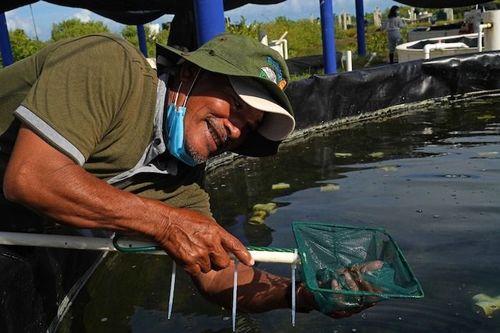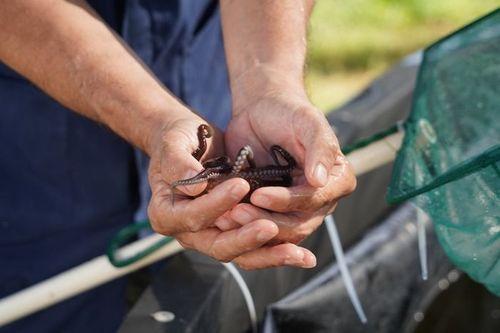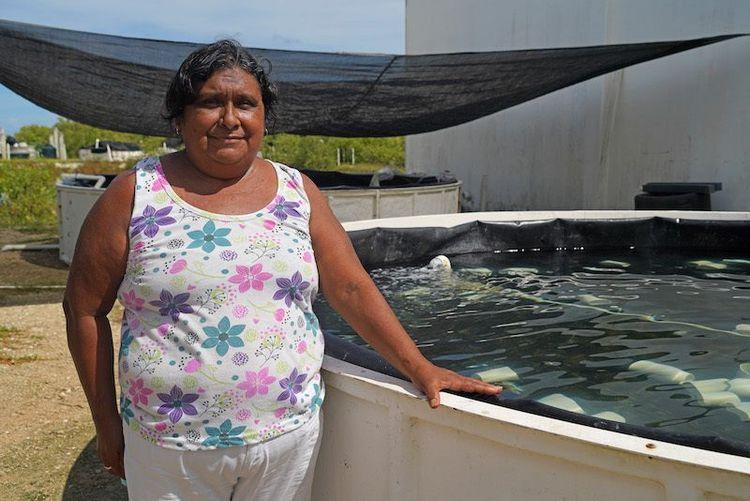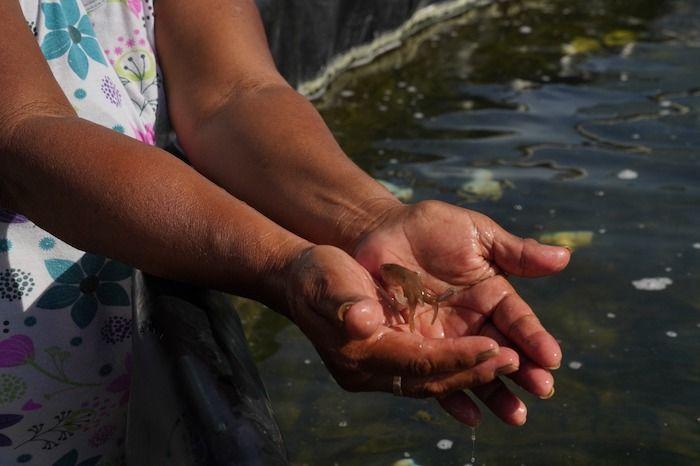Three men and three women are part of the Moluscos del Mayab cooperative, the first cooperative for octopus aquaculture production, a project that seeks to boost the local economy and explore sustainable alternatives to traditional octopus fishing.
In the town of Sisal, in Yucatán, 75 kilometers from Mérida, cooperative members partner with a group of scientists to carry out this initiative, a pioneer at the national and international levels.
The octopus fishery is one of the most important in the country and the most important in terms of volume in the Gulf of Mexico and the Caribbean region, according to data from the National Institute of Fisheries and Aquaculture (Inapesca).

Photo: Claudia Novelo
The Mayan or Red Octopus (Octopus maya), endemic to the Yucatan Peninsula, is the most consumed species in Mexico. The economy of around 15,000 families in the south-east of the country depends on this product, according to official figures.
The idea of seeking alternatives to traditional fishing, in the face of fluctuations in production, is the origin of the project of an aquaculture farm for octopus production, whose technology has taken more than three decades to develop, said Carlos Rosas Vázquez, a researcher at the Faculty of Sciences of the National Autonomous University of Mexico (UNAM).
Rosas Vázquez is the mind behind this project promoted by the UNAM Academic Unit in Sisal, Yucatán, which could revolutionize fishing in the region.
“When we requested the support of the Yucatan government to build the headquarters of the UNAM, one of the issues raised by the then governor was to develop aquaculture processes for octopus cultivation. Former governor Patricio Patrón Laviadal thought that could help solve the octopus shortage at that time and for the future,” said the specialist in physiology and nutrition of marine species.
Until then, octopus production outside the sea had not been possible anywhere in the world. But 17 years later, with dozens of studies, as well as undergraduate and postgraduate theses, there is an approach to the ideal method for producing Mayan octopus through aquaculture, which has served as a basis for research in other countries such as Spain and Japan.
Reproduction outside the sea
Rosas Vázquez has led research to learn about the physiology of octopuses, their digestive and reproductive systems, as well as their behavior and diet.
“The founding of a technology is not something that happens quickly. You had to know very basic things like what do they eat? Can we keep him in a pond for a while? Can we design a food similar to what is eaten in the sea? There were a lot of questions,” the academic explained.

Photo: Claudia Novelo
The first step was to collect females in their natural environment, in the open ocean, and take them to a laboratory pond to examine the process of embryonic development, spawning and parental care.
It takes about a year for a female to reach sexual maturity and embryos develop within 60 days, were the initial discoveries.
Over the months, it was possible to generate optimal light, temperature and feeding conditions for embryonic development and then for the incubation of eggs.
Once they had juvenile octopus, the challenge was to feed them and ensure the highest survival rates.
Today it is known that octopuses have a digestive system whose enzymes are more similar to those of a pig than to those of other invertebrate marine animals. To reach this point, dozens of experiments and studies were carried out, but it was key in the design of the food currently given to the young.
The third major step in the development of the project has been the implementation of processes to scale small-scale production in laboratories to a commercial production system.
From laboratory to commercial cultivation
The first octopus aquaculture production farm, which is based on more than 15 years of research by the UNAM Academic Unit in Sisal, was inaugurated in early 2022 on coastal land, although steps have been taken at least three years in advance, between concession procedures and the installation of infrastructure.

Photo: Claudia Novelo
It was three women from the community who began to collaborate with the UNAM, as an economic alternative to the activity of their husbands, which is fishing.
Later, the spouses themselves joined the project. Aquaculture was, at the time, a viable option for continuing a livelihood activity at an older age, but without the risks involved in going out to the high seas.
This is how the Moluscos del Mayab cooperative was formed. In this phase, the farm is operated independently by the cooperative, with advice from UNAM and with the support of the United Nations (UN) Small Donations Program, explained Daniel Méndez, Doctor of Science and technical advisor to the cooperative.
Méndez was emphatic in pointing out that this is a pilot program, where many areas for improvement are still being explored.
The task is not simple. The members of the cooperative carry out food and care tasks. An error in feeding times could cause them to eat each other.
They must also prepare food, based on fish waste. Each female can produce 1,500 to 2,000 young in each spawn, but not all of them survive, due to the species' cannibalistic instinct.
“We have had survivals of more than 80%, on other occasions much more. Nowadays, the diet continues to be refined to assess which one guarantees greater survival,” said the specialist.
The cooperative currently has an infrastructure capacity to harvest between 500 and 700 specimens of approximately 100 grams each. In the medium term, production is expected to increase to 2,000 copies.
The group is currently not interested in competing with the traditional octopus fishing market, but rather they seek to offer a product with added value, the 'baby octopus', which are smaller specimens and, usually, of greater commercial value.
According to Daniel Méndez, the project contemplates a complete reproduction cycle, meaning that the young are not extracted from the natural environment, but are born, grown and reproduce in the controlled pond.
Sea warming threatens octopus fisheries
The octopus is caught on the high seas by two types of fishing fleets: the smaller fleet and the medium-altitude fleet.
The first one operates along the coast of Campeche, Yucatán and northern Quintana Roo, as well as in the Veracruz Reef System area, with 3,900 vessels. The medium-altitude fleet, with 400 vessels, operates almost exclusively in the port of Progreso, Yucatán, in accordance with the Fisheries Management Plan.
The fishing season runs from December 16 to July 31 of each year, with a closed period of four and a half months.
The Mayan octopus is not a threatened species, but it does face threats due to several factors, mainly related to climate change.
Carlos Rosas stated that the Yucatan Peninsula has an oceanographic dynamic that allows it to maintain some temperature control through a marine current that carries relatively fresh water from the seabed to the surface. This phenomenon is known as' upwelling ', and it is usually nutrient-laden waters and is beneficial for octopus populations.
“However, there is oceanographic evidence that indicates that the current that supplies the upwelling is weakening, and that could result in an increase in temperature on the Yucatan platform,” he said.
Both Carlos Rosas and Daniel Méndez agree that octopus fishing is still “highly productive”. It is estimated that around 30 thousand tons were extracted in 2021.
With regard to poaching, he mentioned that, in proportion to the magnitude of fish production, it does not represent a serious threat.
For experts, environmental variations are the main factor of concern.
Rosas said that the aquaculture production alternative also reduces pressure on natural ecosystems and offers sustainable solutions to the demand for this species.



Comentarios (0)